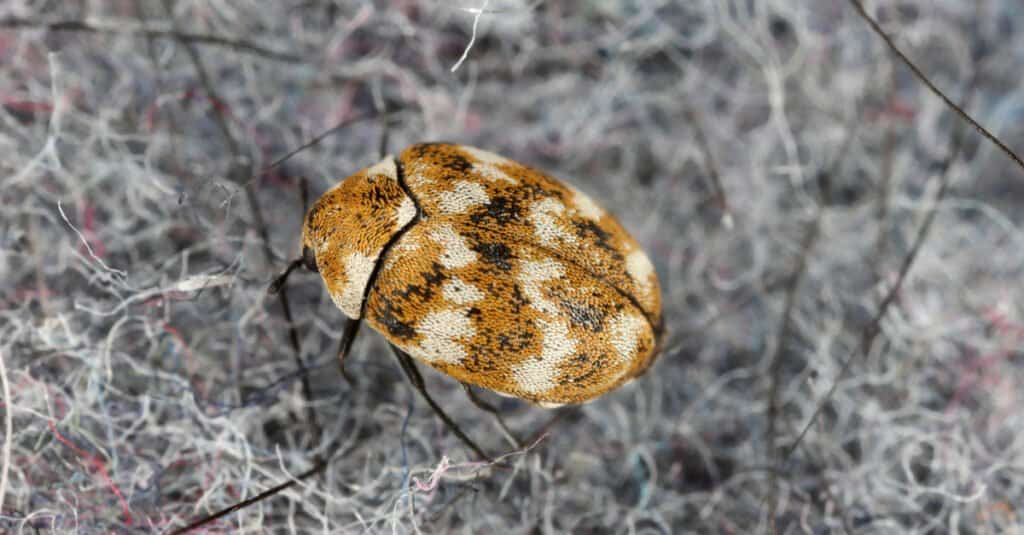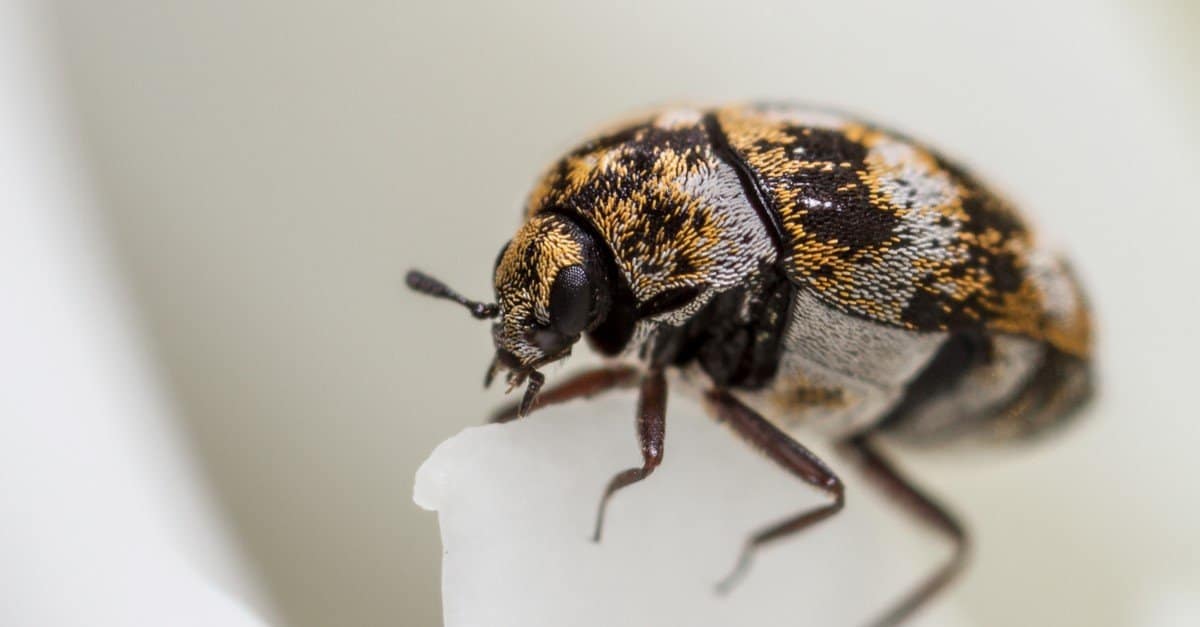Carpet beetles are tiny insects that resemble ladybugs or bed bugs. Adults are quite small, less than 1/8-inch long in size, and oval in shape. Most have varying shades of brown, white, black, yellow, or reddish-orange in a variegated pattern, although you may occasionally find black carpet beetles.
Adult carpet beetles do not cause problems in homes; rather, their larvae are the culprits and do damage inside homes. The larvae for each type of carpet beetle look slightly different, yet they have several defining identification characteristics.
The larvae are the ones you need to pay attention to as they are the ones that will cause damage in your home.
Carpet beetle eggs are creamy or white and are less than .01 inches in size. You’ll often find these oval-shaped eggs deposited in groups in blankets or clothing that are infrequently used.
Larvae are oval-shaped bugs that generally have black, light brown, white, and yellow coloring and are one inch or less in length. They are often mistaken for caterpillars as they are covered in dense, barbed hair.
Carpet beetle larvae identification is slightly different for each species, yet you can count on these general descriptions to identify the pests.
Life Cycle of Carpet Beetles
Most carpet beetles lay eggs indoors, although they sometimes choose the nests of other insects, birds, and mice outside. Each female lays 50 to 100 eggs that hatch into larvae anywhere from seven to 35 days, depending on the species.
These bugs also have a pupal stage that varies. The young bugs develop into adults within nine months to two years. Adults only live a few weeks.
All over the country, carpet beetles are considered to be very common inspects found around the house. There’s probably a good chance you’ve seen one from time to time. There are various carpet beetle species such as the black carpet beetle of the furniture carpet beetle.
They’re usually considered to be oval in shape and dark brown in color.

©Tyler Fox/Shutterstock.com
Habitat of Carpet Beetles
Carpet beetles are found throughout the United States. Their habitat also includes most of Europe, along with the Near East, Northern Asia, Northern Africa, and Central and South America through the latter’s temperate zones. You’ll find several different species of carpet beetles, including the black carpet beetle, furniture carpet beetle, and varied carpet beetle. Black carpet beetles and varied carpet beetles are the ones most likely to cause damage inside your home.
Female beetles lay eggs near furniture, clothing, rugs, and other larval food sources.
Signs of Infestation
Adult beetles do not cause damage as they are attracted to light and prefer the outdoors, feeding on flowering plants. Adult bugs fly into homes in warm spring weather through open doors and windows. Carpet beetle larvae are the ones that cause damage in your home as they eat various types of organic, animal-based products. Their food sources include:
- Woolens
- Furs
- Animal dander
- Leather
- Feathers
- Lint
- Felt
- Dead insects
- Dry pet food
- Carpets
- Furniture. fabrics
- Organic clothing
- Organic/synthetic mix clothing
Because adults are capable fliers, they can move rapidly from room to room, laying their eggs to cause the signs of an infestation. The facts are, almost every home has carpet beetles somewhere, but you shouldn’t panic unless you begin seeing these telltale signs:
- Bare areas on wool or wool-blend carpets and rugs
- Damage to wool clothes, blankets, and similar items, as the larvae eat the nap from fabric surfaces
- Hairs fall out of furs where larvae have clipped the hairs off at their base
- Light brown, empty larval skins in areas where the larvae feed
- Tiny beetles, which are smaller than the larvae, climbing walls or along window sills

©Tomasz Klejdysz/Shutterstock.com
Bites Caused by Carpet Beetles?
Carpet beetles are generally harmless to humans. However, facts show that the larvae can cause an allergic skin rash if they come into contact with your skin. The small, hair-like bristles are the irritants that can cause the rash, which can be confused with bites. The bumpy, itchy rash that they produce is another reason why the identification of carpet beetles is often confused with bed bug bites. These bugs are also similar in size, which adds to the uncertainty.
Treatment and Prevention
For severe infestations, experts recommend using the services of a pest control company to get rid of these insects. Vacuuming before treatment can get rid of potential food sources.
Applying boric acid crystals to baseboards, cracks, and crevices will also help get rid of the larvae. Sprinkling boric acid over affected areas and letting this treatment sit for several hours will kill larvae.
Make sure that you vacuum thoroughly to remove all of the boric acid as it can be harmful to pets and humans. Using cedar oil can also act as a repellant as a means of prevention.
Rather than ridding your home of an infestation, prevention is a better cure. Follow these tips to eliminate an indoor habitat:
- Vacuum furs, woolens, carpets and furniture regularly to eliminate lint, pet hair, dirt and other organic debris
- Store winter clothing in air-tight bags or cedar closets
- Clean frequently under furniture and other hard-to-reach places
- Remove nests from birds, rodents and wasps, all of which can lead to infestations
- Clean your chimney once a year as it can become a breeding ground for larvae
- Having woolens or furs professionally cleaned can help limit infestations
Next Up…
- Devils Coach Horse Beetle – The scientific name of the Devil’s coach horse beetle is Ocypus olens. This translates to “smelling.” Learn why this beetle is named after that!
- The Life Cycle of a Beetle – Learn about each stage of the beetle life cycle now!
- 10 Incredible Beetle Facts – Some of these beetle facts may surprise you, click to learn why!
Thank you for reading! Have some feedback for us? Contact the AZ Animals editorial team.








